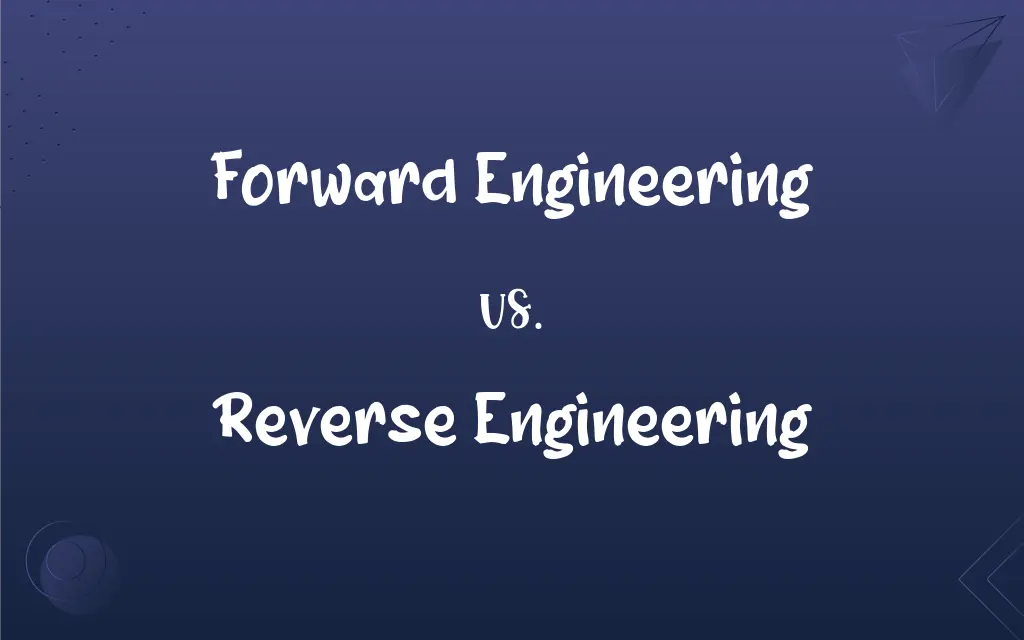Forward Engineering vs. Reverse Engineering: What's the Difference?
Edited by Aimie Carlson || By Janet White || Published on February 12, 2024
Forward Engineering refers to creating systems from specifications. Reverse Engineering refers to understanding systems by analyzing their structure.

Key Differences
Forward engineering involves the process of moving from high-level abstractions and logical designs to the physical implementation of a system. On the other hand, reverse engineering begins with the final product and works backward to deduce design specifications. Both involve a deep understanding of the system, but their approaches are fundamentally opposite.
In forward engineering, the focus is on building systems based on predetermined requirements and design documents. Conversely, reverse engineering involves deconstructing and analyzing a system to understand its workings, often without access to its original design. Both require a systematic approach, yet their objectives and starting points differ.
Forward engineering is often used in the development of new software or systems, following a step-by-step methodology to bring a concept to reality. Reverse engineering, in contrast, is typically used to examine existing products, either to replicate or to understand their structure for maintenance or improvement. Each serves distinct purposes in the realm of engineering and development.
Forward engineering is a process driven by innovation and creation, often associated with the development of new technologies. Reverse engineering, however, is driven by analysis and understanding, frequently used in situations where documentation is lacking or for learning purposes. Each represents different facets of the engineering process.
Forward engineering is a proactive process, involving planning, designing, and implementing. Reverse engineering is reactive, focusing on dissecting and examining something that already exists. Both play critical roles in the lifecycle of products and systems, offering different perspectives on the engineering process.
ADVERTISEMENT
Comparison Chart
Purpose
Develops new systems from concept
Understands existing systems by analysis
Process
Starts with design, ends with product
Starts with product, ends with design
Usage
Common in original software/system development
Common in learning, maintenance, or copying
Approach
Proactive, planning-driven
Reactive, analysis-driven
Outcome
Innovative creation
Detailed understanding
ADVERTISEMENT
Forward Engineering and Reverse Engineering Definitions
Forward Engineering
Designing and developing new systems from scratch.
The team engaged in forward engineering to create a novel mobile application.
Reverse Engineering
Analyzing the construction of a system to replicate or enhance it.
Through reverse engineering, the team was able to create a compatible accessory for the device.
Forward Engineering
Applying a systematic approach to develop new technologies.
The company's forward engineering process led to the invention of a new solar panel design.
Reverse Engineering
Extracting knowledge or design information from anything man-made.
By reverse engineering the ancient artifact, scientists discovered its utility in agriculture.
Forward Engineering
Transforming conceptual models into fully functional systems.
Forward engineering was utilized to turn the architectural blueprints into a tangible building.
Reverse Engineering
Disassembling products to understand their design and functionality.
Reverse engineering the competitor's gadget revealed its innovative circuit design.
Forward Engineering
Progressing from theoretical design to practical implementation.
Through forward engineering, the prototype was successfully converted into a market-ready product.
Reverse Engineering
Deconstructing software to understand its code and architecture.
The programmers used reverse engineering to uncover the algorithm of the legacy software.
Forward Engineering
Implementing software from documented requirements and specifications.
Their forward engineering methodology resulted in a robust and user-friendly software platform.
Reverse Engineering
Understanding existing products to innovate or improve upon them.
Reverse engineering was essential in enhancing the current model of the car for better performance.
Reverse Engineering
Infl of reverse-engineer
FAQs
What is reverse engineering?
It involves analyzing a finished product to understand its design and functionality.
Can reverse engineering be used for legal purposes?
Yes, when used for learning, compatibility development, or when it doesn’t infringe on intellectual property rights.
In what fields is forward engineering commonly used?
In software development, architecture, engineering, and technology innovation.
How does forward engineering contribute to innovation?
It turns novel ideas into tangible, functional products or systems.
What is forward engineering?
It's the process of developing a system from concept to physical form.
Is forward engineering limited to physical products?
No, it applies to software and systems as well.
Why might a company engage in reverse engineering?
To learn from competitors, improve existing products, or ensure compatibility.
How do forward and reverse engineering differ in purpose?
Forward engineering aims to create new systems, while reverse engineering aims to understand or replicate existing ones.
What skills are important for reverse engineering?
Analytical skills, attention to detail, and understanding of design principles.
Is forward engineering a linear process?
Generally, yes, progressing from design to development to implementation.
Is forward engineering always based on new ideas?
Mostly, but it can also involve improving or modifying existing designs.
Does reverse engineering always require physical disassembly?
Not always; it can also involve code analysis or non-intrusive methods.
What role does documentation play in forward engineering?
It's crucial for guiding the development process and maintaining consistency.
Are there ethical concerns with reverse engineering?
Yes, particularly regarding intellectual property rights and privacy.
How does reverse engineering support maintenance?
By understanding how a product works, it aids in repairing or upgrading it.
What is a key challenge in forward engineering?
Translating theoretical designs into practical, efficient, and functional products.
Can reverse engineering be used for educational purposes?
Yes, it’s often used to teach engineering, design principles, and problem-solving.
Can reverse engineering lead to new inventions?
Yes, by understanding existing products, it can inspire innovative improvements or alternative applications.
How does reverse engineering help in software development?
It aids in understanding existing code, fixing bugs, or enhancing features.
What is a common goal of forward engineering in technology?
To bring new, innovative technologies to market.
About Author
Written by
Janet WhiteJanet White has been an esteemed writer and blogger for Difference Wiki. Holding a Master's degree in Science and Medical Journalism from the prestigious Boston University, she has consistently demonstrated her expertise and passion for her field. When she's not immersed in her work, Janet relishes her time exercising, delving into a good book, and cherishing moments with friends and family.
Edited by
Aimie CarlsonAimie Carlson, holding a master's degree in English literature, is a fervent English language enthusiast. She lends her writing talents to Difference Wiki, a prominent website that specializes in comparisons, offering readers insightful analyses that both captivate and inform.







































































